
Kōwhai are small woody legume trees within the genus Sophora, in the family Fabaceae, that are native to New Zealand. There are eight species, with Sophora microphylla and S. tetraptera being the most recognised as large trees. Their natural habitat is beside streams and on the edges of forest, in lowland or mountain open areas. Kōwhai trees grow throughout the country and are a common feature in New Zealand gardens. Outside of New Zealand, kōwhai tend to be restricted to mild temperate maritime climates.

Alectryon excelsus, commonly known as tītoki, or sometimes New Zealand oak, is a shiny-leaved tree native to New Zealand. It is in the family Sapindaceae. It lives in coastal and lowland forests throughout most of the North Island and from Banks Peninsula to central Westland in the South Island.

Aristotelia serrata, commonly known as wineberry or in the Māori language makomako or just mako, is a small tree in the family Elaeocarpaceae, in the genus Aristotelia, found in the North Island, South Island and Stewart Island of New Zealand. It is a small deciduous fast-growing tree or shrub. The tree can reach up to 10m tall, with a trunk diameter up to 30 cm. The bark is pale brown, smooth and patterned with flat lenticels. Branches are long, slender and spreading, branchlets have a reddish-brown colour when pubescent.

Knightia excelsa, commonly called rewarewa, is an evergreen tree endemic to the low elevation and valley forests of New Zealand's North Island and Marlborough Sounds and the type species for the genus Knightia.

Urtica ferox, commonly known as tree nettle and, in Māori, ongaonga, taraonga, taraongaonga, оr okaoka, is a species of nettle endemic to New Zealand. Unlike the other species in the genus Urtica found in New Zealand, all of which are herbaceous, ongaonga is a large woody shrub that can grow to a height of 3 m (9.8 ft), with the base of the stem reaching 12 cm (4.7 in) in thickness. It has large spines that can result in a painful sting that lasts several days.

Arthropodium cirratum is a species of herbaceous perennial plant, endemic to New Zealand, where it may once have been farmed. It is used for medicine as well as food, and has symbolic importance in traditional Māori culture.

Tetragonia tetragonioides, commonly called New Zealand spinach, Warrigal greens and other local names, is a flowering plant in the fig-marigold family (Aizoaceae). It is often cultivated as a leafy vegetable.

Earina mucronata is species of plant endemic to New Zealand. The specific epithet means "pointed" and refers to the shape of the tips of this orchid's very narrow leaves. The leaves are arranged alternately in one plane along a flattened, unbranched pseudobulb which can grow up to 1 m in length but which is generally shorter. As in most Monocotyledons the base of each leaf is extended into a leaf sheath which completely encircles the stem, in this species they are greatly elongated and extend the full length of the internode. The sheaths are 2 or 3 mm wide and in contrast to those of E. autumnalis they are difficult to pull off. Another key distinguishing feature of this species are the tiny, ubiquitous black spots which cover the leaf sheaths as well as many of the leaves themselves - these are notably absent in autumnalis.
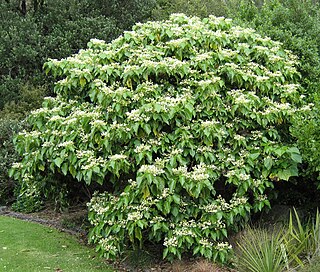
Entelea arborescens or whau is a species of malvaceous tree endemic to New Zealand. E. arborescens is the only species in the genus Entelea. A shrub or small tree to 6 m with large lime-like leaves giving a tropical appearance, whau grows in low forest along the coast of the North Island and the northern tip of the South Island. The dry fruit capsules are very distinctly brown and covered with spines. The common name whau is a Māori word that appears to derive from the common Polynesian word for hibiscus, particularly Hibiscus tiliaceus, which it superficially resembles. Alternate names include 'New Zealand mulberry', 'corkwood' and 'evergreen lime'.

Elaeocarpus dentatus, commonly known as hinau, is a native lowland forest tree of New Zealand. Other names in Māori for the tree are hangehange, pōkākā, and whīnau.
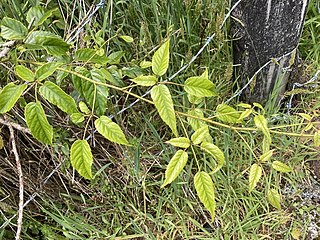
Rubus cissoides, commonly called bush lawyer or tātarāmoa in te reo Māori, is a species of flowering plant in the family Rosaceae, endemic to New Zealand. Alan Cunningham described R. cissoides in 1839. Plants of this species of are perennial scrambling vines with compound leaves with 3-5 leaflets each up to 15 cm long, reddish prickles on the branches, white flowers from September to November and red berries from December to April. The conservation status of R. cissoides is Not Threatened, it is widespread on all three main islands of mainland New Zealand, and it has been used by Māori as food, medicines and construction materials.

Veronica salicifolia, synonym Hebe salicifolia, the koromiko, or willow-leaf hebe, is a flowering plant in the family Plantaginaceae, which is found throughout the South Island of New Zealand and in Chile. It is a large, evergreen shrub, reaching 2 m in height, with light-green, spear-shaped leaves that are up to 12 cm long, and white or pale lilac flowers.
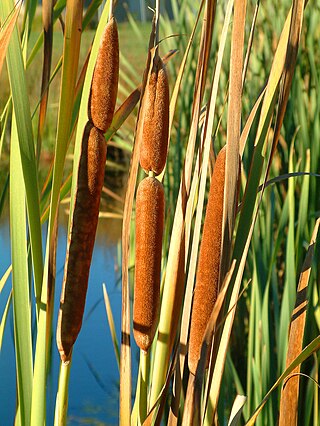
Typha orientalis, commonly known as bulrush, cumbungi, or raupō, is a perennial herbaceous plant in the genus Typha. It is native to Australia, New Zealand, Malaysia, Indonesia, Japan, Korea, Mongolia, Myanmar, Philippines, China and the Russian Far East.
Coriaria pottsiana, commonly called the Hikurangi tutu or Pott's tutu, is a rare low-growing sub-alpine perennial summer-green shrub, only known to exist on a small grassy scree slope behind the tramping hut on Mount Hikurangi in the Gisborne Region of New Zealand's North Island. The Mt Hikurangi tramping hut is found at 37°54′22″S178°3′31″E.
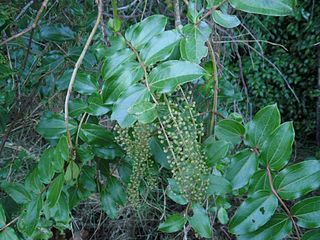
Coriaria arborea is a highly poisonous and common native shrub or small tree of New Zealand. The common name for this and the other New Zealand species of Coriaria is tutu.

Passiflora tetrandra is a climbing vine found in New Zealand. The Māori name for the plant is kōhia. Other common names include New Zealand passionflower and New Zealand passionfruit. Of the c.500 species of passionflower, this is the sole representative from New Zealand and endemic to New Zealand.

Jovellana repens is an endemic New Zealand plant in the family Calceolariaceae spread through both the North and South Islands. It has small green leaves and white flowers with spots of purple on the inside.
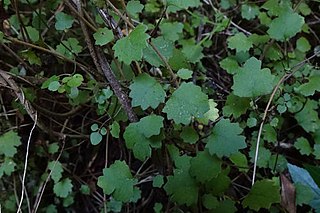
Brachyglottis sciadophila, commonly known as climbing groundsel, is a flowering plant in the family Asteraceae. It has long stems with small green leaves and bright yellow flowers. It is the only climbing daisy which has yellow flowers that is endemic to New Zealand.

Myosotis chaffeyorum is a species of flowering plant in the family Boraginaceae, endemic to the South Island of New Zealand. Carlos Lehnebach described the species in 2012. Plants of this species of forget-me-not are perennial with a creeping habit, bracteate inflorescences, and white corollas.

Myosotis bryonoma is a species of flowering plant in the family Boraginaceae, endemic to the South Island of New Zealand. Heidi Meudt, Jessica Prebble and Michael Thorsen described the species. Plants of this species of forget-me-not are perennial with a creeping habit, bracteate inflorescences, and white corollas.





















